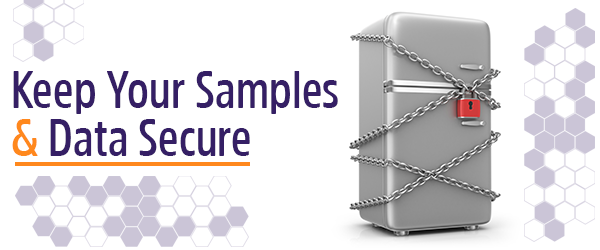
Tamper-evident labels
Tamper-evident labels tear up or shred to pieces if anyone attempts to remove them. These labels conform to the precise shape of tubes, vials, or storage boxes, rendering any attempt to open the container obvious to the owner and informs them that someone has tampered with the sample. They’re typically used to secure valuable or sensitive biological material, such as sperm, oocytes, and embryos as well as hazardous or infectious bacteria, viruses, and microbes, during storage or transportation.
Labels for discarding sensitive information
It’s often necessary to discard labels carrying sensitive data, such as patient information or confidential experimental data. However, once thrown out, this information must remain confidential and secure, no matter where it ends up. Here are two quick and inexpensive options that can help permanently block-out private data: direct-thermal labels and blackout labels.
- Direct-thermal labels – Direct-thermal labels are coated with a leuco-dye that turns black when heat is applied to it. Normally, these labels are printed with a thermal printer, which applies heat to produce letters, numbers, or barcodes. Once the label is no longer needed, they can be autoclaved, which will turn the entire label black, obscuring all confidential information.
- Blackout labels – These labels are made with an opaque material that allows you to place them over pre-existing labels, concealing sensitive patient samples, or product information.
LIMS security features
If your lab uses a laboratory information management system (LIMS) to efficiently track and trace samples, you should make sure that it’s ISO certified. This is especially important for cloud-based LIMS. Though these types of systems are easily accessible, they may also go against your company’s security policy. Having an ISO certification (ISO/IEC 27001:2013, for example) means that the organization you’re doing business with must maintain and continually improve their information security management system. There are also guidelines for assessing and treating information security risks that the company will customize to meet the needs of your business. That way, you can be sure the cloud-based LIMS you’re running will lock out unauthorized personnel from breaching the system.
Physical security measures
There are several ways to physically safeguard your lab. Every lab I’ve ever worked in used keycards to limit who can enter the space. While keycards are a staple of scientific and medical labs, they often just restrict access at the main entrance of the building. For academic labs, this means that anyone who enters the building, including grad students and staff from other labs, will have full access to your lab as well. There are a couple of ways to safeguard against this. One solution is implementing radio-frequency identification (RFID) technology. Tagging valuable samples and equipment with RFID labels allows you to keep track of them and will let you know if they have been removed from the lab. These labels will also allow you to keep confidential information secret from any non-authorized personnel. Visual monitoring is another layer of security that can be used to determine if anyone is inappropriately accessing your samples, inventory, or results. It doesn’t have to be expensive either; quality miniature cameras that surveil your lab, along with cloud-based recording, can be purchased on the cheap. However, large pharmaceutical labs that adhere to strict regulations, like the Controlled Drugs and Substances Act (CDSA), which restricts access to controlled drugs and other substances, may require more elaborate visual monitoring systems.
It also pays to have a system in place that monitors the infrastructure of your lab. You need to know if your equipment or storage tanks are working at peak efficiency, and to find out, you need a system that will tell you if the parameters of your equipment are behaving normally. There are cloud-based systems, like XiltriX, which monitor things such as temperature, humidity, and the presence of contaminants in your incubators, liquid nitrogen Dewars, and your lab’s airflow. Because they’re cloud-based, they can send a warning immediately when something is off, making power outages, unwanted contaminants, and tampering with equipment less likely to ruin samples and/or inventory.
Blockchain
Blockchain is a system that stores data in interconnected blocks by linking them together in a chain. The chain comes with a “hash”, a form of computerized output, that is determined by the information stored on the chain. If a block is manipulated in any way—by someone trying to tamper with it, for instance—the hash will change for the entire chain, alerting users that the data has been tinkered with. Only those with the right encryption keys can access the blockchain, and since the entire system is decentralized (that is, stored on multiple computers, or nodes), any change made to the data would have to be made across every single copy of the blockchain, each of which resides in a different location. Blockchain is mainly being implemented for safeguarding medical health records but has also been used to secure data from pharmaceutical supply chains and clinical trials.
With so much invested in samples, inventory, equipment, and results, it’s crucial to have everything secured in your lab. These solutions help make sure that all bases are covered when it comes to preventing a security breach, no matter the type. This means fewer resources spent on tracking and tracing stolen or altered data and samples, and more spent on tracking and tracing your samples during an assay instead.
LabTAG by GA International is a leading manufacturer of high-performance specialty labels and a supplier of identification solutions used in research and medical labs as well as healthcare institutions.